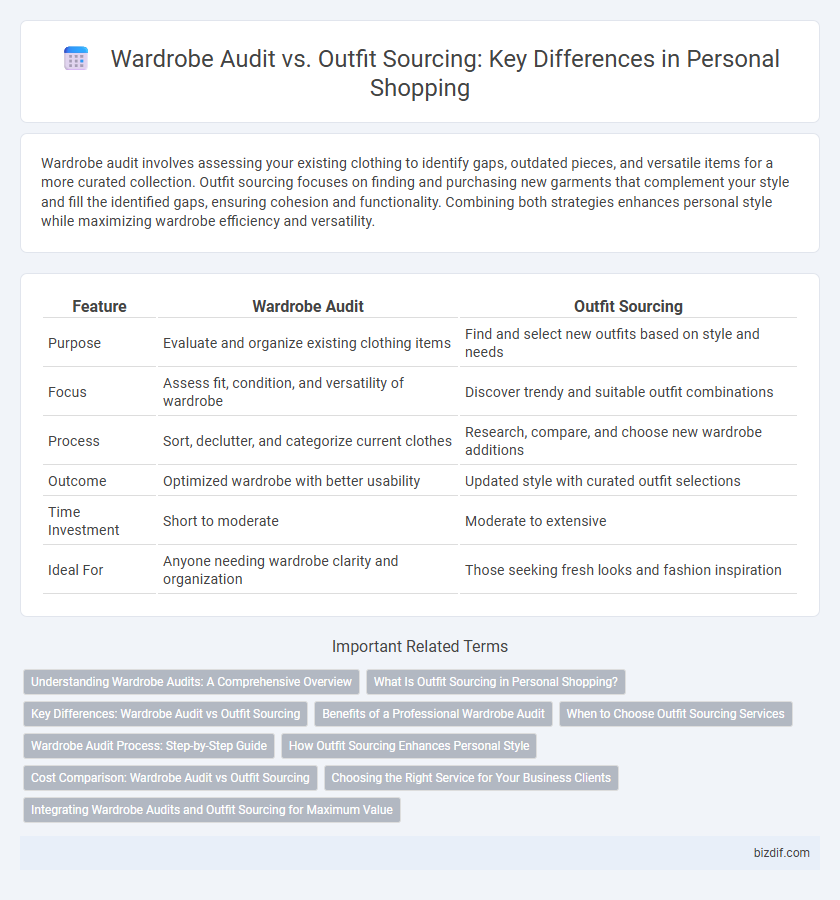Wardrobe audit involves assessing your existing clothing to identify gaps, outdated pieces, and versatile items for a more curated collection. Outfit sourcing focuses on finding and purchasing new garments that complement your style and fill the identified gaps, ensuring cohesion and functionality. Combining both strategies enhances personal style while maximizing wardrobe efficiency and versatility.
Table of Comparison
| Feature | Wardrobe Audit | Outfit Sourcing |
|---|---|---|
| Purpose | Evaluate and organize existing clothing items | Find and select new outfits based on style and needs |
| Focus | Assess fit, condition, and versatility of wardrobe | Discover trendy and suitable outfit combinations |
| Process | Sort, declutter, and categorize current clothes | Research, compare, and choose new wardrobe additions |
| Outcome | Optimized wardrobe with better usability | Updated style with curated outfit selections |
| Time Investment | Short to moderate | Moderate to extensive |
| Ideal For | Anyone needing wardrobe clarity and organization | Those seeking fresh looks and fashion inspiration |
Understanding Wardrobe Audits: A Comprehensive Overview
Wardrobe audits involve systematically reviewing and categorizing existing clothing to identify gaps, redundancies, and style alignment. This process helps optimize outfit planning by highlighting pieces that can be repurposed or retired, improving overall wardrobe efficiency. Understanding wardrobe audits enables personalized shopping strategies that complement current apparel, ensuring budget-friendly and cohesive outfit sourcing.
What Is Outfit Sourcing in Personal Shopping?
Outfit sourcing in personal shopping involves selecting and curating complete looks tailored to an individual's style, body type, and lifestyle, ensuring cohesive and functional wardrobe choices. This process leverages fashion expertise to identify pieces that not only complement existing clothing but also elevate personal style with seasonal trends and versatile options. Unlike a wardrobe audit, which assesses current items for usability, outfit sourcing focuses on proactive acquisition and styling for immediate wear and confidence boost.
Key Differences: Wardrobe Audit vs Outfit Sourcing
Wardrobe audit involves a thorough evaluation of existing clothing to identify gaps, fit issues, and style preferences, promoting better organization and mindful consumption. Outfit sourcing focuses on selecting and curating complete looks by combining items from various brands or collections to create cohesive, stylish ensembles tailored to specific occasions. The key difference lies in wardrobe audit optimizing current pieces for longevity and versatility, while outfit sourcing emphasizes acquiring new items to achieve desired aesthetics and functionality.
Benefits of a Professional Wardrobe Audit
A professional wardrobe audit identifies gaps and redundancies in your clothing collection, enhancing outfit versatility while saving time and money. Experts analyze fit, style, and current trends to curate a personalized capsule wardrobe that maximizes your existing pieces. This targeted approach boosts confidence and streamlines daily dressing by aligning your wardrobe with your lifestyle and fashion goals.
When to Choose Outfit Sourcing Services
Outfit sourcing services are ideal when you need to quickly update your wardrobe with cohesive looks tailored to your lifestyle and body type, especially during season changes or special events. These services save time by curating complete outfits based on your personal style preferences and current fashion trends. Opt for outfit sourcing when you prefer convenience and expert guidance to achieve a polished, ready-to-wear appearance without the hassle of piecing items together.
Wardrobe Audit Process: Step-by-Step Guide
Wardrobe audit involves systematically evaluating clothing items to identify gaps, misfits, or outdated pieces, ensuring a cohesive and functional closet. The process includes categorizing garments by type and condition, assessing style alignment with personal preferences, and noting what essentials or statement items are missing. This methodical approach boosts shopping efficiency by highlighting precise needs, minimizing impulse buys, and optimizing future outfit sourcing.
How Outfit Sourcing Enhances Personal Style
Outfit sourcing enhances personal style by curating clothing and accessories tailored to individual body shape, color preferences, and lifestyle needs, resulting in cohesive and versatile ensembles. This personalized approach goes beyond wardrobe audit's inventory assessment by actively introducing new pieces that complement existing items and elevate overall aesthetics. Clients experience increased confidence and effortless styling through thoughtfully selected outfits that reflect their unique identity.
Cost Comparison: Wardrobe Audit vs Outfit Sourcing
Wardrobe audits typically incur lower costs as they focus on assessing and organizing existing clothing pieces, minimizing unnecessary purchases. Outfit sourcing often involves higher expenses due to the need to buy new items tailored to specific styles or occasions. Choosing between the two depends on budget constraints and the goal of either maximizing current wardrobe utility or refreshing the collection with new investments.
Choosing the Right Service for Your Business Clients
Wardrobe audit evaluates a client's existing clothing to identify gaps and optimize style, enhancing wardrobe efficiency and investment value. Outfit sourcing provides curated selections tailored to specific needs, facilitating brand consistency and time management for business clients. Selecting the right service depends on a client's current wardrobe state and their goals for image refinement or expansion.
Integrating Wardrobe Audits and Outfit Sourcing for Maximum Value
Integrating wardrobe audits with outfit sourcing delivers maximum value by identifying gaps and redundancies in your current clothing collection while pinpointing key pieces needed to complete versatile looks. This combined approach optimizes personal style, ensuring every item serves a purpose in creating cohesive, functional outfits that reflect individual preferences. Leveraging insights from wardrobe analysis enhances sourcing decisions, minimizing impulse buys and fostering mindful, strategic shopping.
Wardrobe Audit vs Outfit Sourcing Infographic

 bizdif.com
bizdif.com